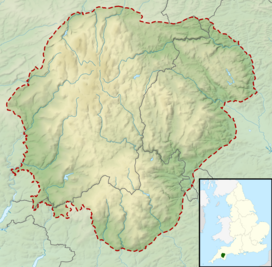Cawsand Beacon
| Cosdon Hill | |
|---|---|
| Cosdon Beacon, Cawsand Beacon | |
|
Looking south-south-west from Sampford Courtenay towards Dartmoor with Cosdon Hill prominent on the left
|
|
| Highest point | |
| Elevation | 550 m (1,800 ft) |
| Parent peak | High Willhays |
| Coordinates | 50°42′25″N 3°55′59″W / 50.707048°N 3.933017°WCoordinates: 50°42′25″N 3°55′59″W / 50.707048°N 3.933017°W |
| Geography | |
| Location | Dartmoor, England |
| Parent range | Dartmoor |
Cosdon Hill, also called Cosdon Beacon, or Cawsand Beacon, is one of the largest hills on Dartmoor, in Devon, England. It has numerous traces of prehistoric occupation.
Cosdon. is a large, rounded hill that rises to 550 metres (1,800 ft) The first written record of the hill is to the Hoga de Cossdonne in 1240. The name Cossdonne seems to mean "Cost(a)'s hill", where "Cost" or "Costa" is the name of a person.
The shape of the hill gives a false impression of size, and for many years Cosdon was thought to be the highest on Dartmoor. The surveyors of the Principal Triangulation of Great Britain took bearings that resulted in the first Ordnance Survey map of Dartmoor in 1809, which showed that Yes Tor was higher. However, in 1830 Samuel Rowe still wrote that Cawson or Cosdon hill was the highest in Dartmoor. An 1894 guide for cyclists going from Exeter to Launceston said, "So vast is the bulk of Cosdon that, were is not for the cloud mists that so often drift round his brow, one would hardly at first sight credit his height of 1799 feet." It noted that until recently Yes Tor had been thought to be the highest point at 2,029 feet (618 m), but it was now known that the neighbouring High Willhays was yet higher, at 2,039 feet (621 m).
From the summit of Cosdon it is often possible to see the English Channel from Teignmouth to Start Point, and on a clear day the Bristol Channel may be visible. The hill provides an excellent view over Dartmoor. As Thomas Clifton Paris wrote in 1865, "Far and wide stretch its desolate hills, the ancient haunt of wolves and wild deer, and barbarians as untamed ; a solitary wondrous region, everywhere darkened by morasses, but piled with fantastic rocks and glowing with innumerable tints."
A Neolithic flint axe has been found at the western foot of the hill. There were nine Bronze Age settlements around the western edge of the hill and two associated reaves, or stone walls, that may have marked the boundaries between territories. There are also many stone cairns, kistvaens, stone rows and what may be a stone circle. Some of these have been badly damaged by stones being removed later for other uses. There is a very large cairn on the summit, which may well have been the site of a beacon.
...
Wikipedia

